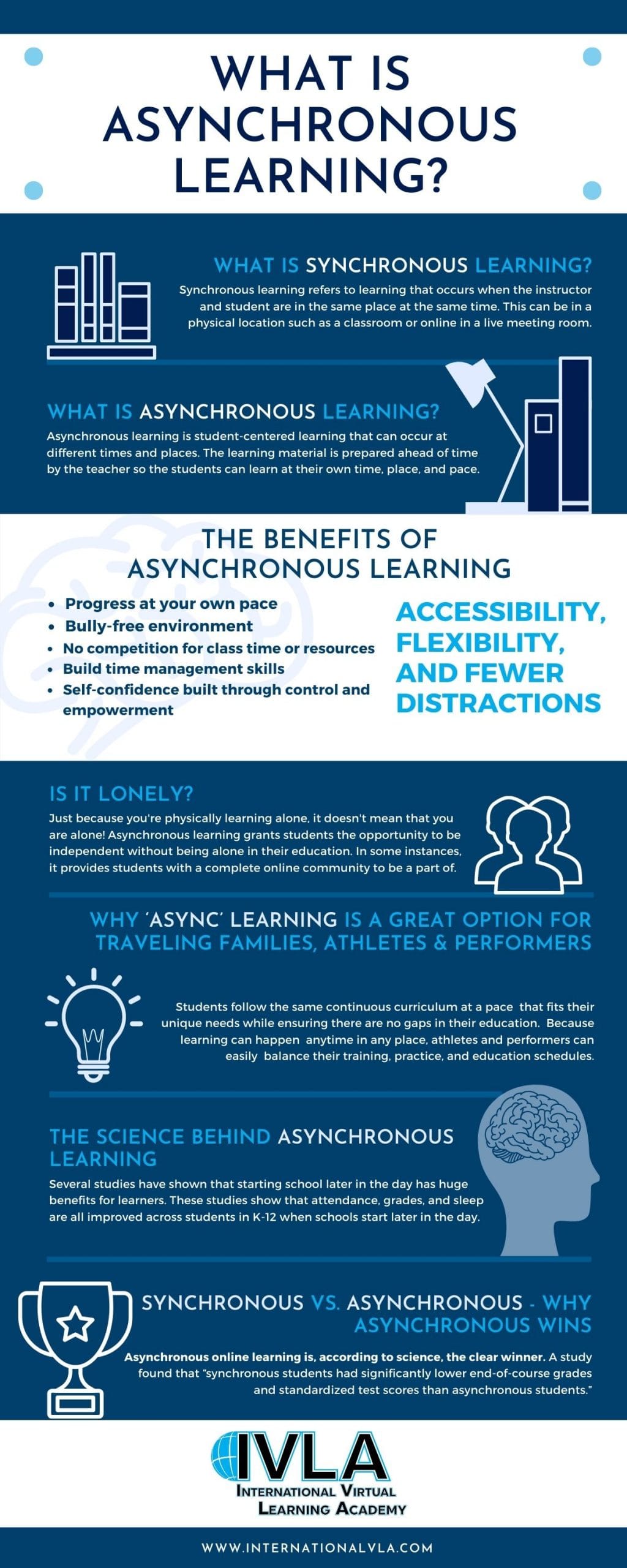Table of Contents:
- Introduction
- Synchronous Learning vs. Asynchronous Learning
- Synchronous Learning (Live Classes)
- Definition
- How it differs from distance learning
- Asynchronous Learning
- Definition
- Benefits of Asynchronous Learning
- Is it Lonely?
- Why it’s a great option for Military and Other Traveling Families
- Synchronous Learning (Live Classes)
- The Future of Education - Is it Asynchronous Learning?
- What the Science Tells Us
- Starting School Later is Actually Better!
- Synchronous vs. Asynchronous - Why Asynchronous Wins
Introduction
The number of students attending school online has greatly increased over the years particularly this last year due to the COVID-19 pandemic. Students are adapting to learning online in either synchronous or asynchronous classes. Parents looking for an online program, often search for programs that offer synchronous courses; however, research shows students prefer asynchronous learning and have better performance outcomes in asynchronous environments.
 Synchronous Learning (Live Classes) vs. Asynchronous Learning
Synchronous Learning (Live Classes) vs. Asynchronous Learning
To define asynchronous learning, it's important to understand what synchronous learning is first.
What is Synchronous Learning?
Synchronous learning is a style of learning very similar to brick-and-mortar schools, except that you aren’t in the same room as other students.
Synchronous learning refers to learning that occurs when the instructor and student are in the same place at the same time. This can be in a physical location such as a classroom or online in a live meeting room.. The defining feature of this method is the real-time exchange of information between instructor and students online or virtually. This can happen either in-person or on the internet through video conferencing software where teachers and students can engage remotely in real time.
OK, that makes sense! But how is it any different from distance learning?
Most commonly, you'll hear people using the terms distance education or distance learning when talking about taking classes online. Synchronous learning is not a type of distance learning, but can be done via distance learning, and shares many similarities with a regular classroom. You still have a teacher, you still have to be up on time to get to your lessons, and you'll still have classmates participating in a class at the exact same time as you.
What is Asynchronous Learning?
Asynchronous learning happens on your schedule - no early alarm required.
One of the most convenient perks of distance learning is the ability to learn “when it fits my schedule.” Traditional courses provide set times and locations where students are expected to be present.
Asynchronous learning is student-centered learning that can occur at different times and places. The learning material is prepared ahead of time by the teacher so the students can learn at their own time, place, and pace. The students and the teacher do not have to be in the same place at the same time. Asynchronous learning has many benefits including flexibility, working at your own pace, personalized learning, and fewer distractions. Asynchronous methods are often used in online courses because they allow students to interact with others in their class but don’t require them to be present simultaneously.
The benefits of asynchronous learning:
- Age does not matter - You can find classes for any grade level, including traditional K-12 schooling.
- Location does not matter - As long as you have an internet connection, you're good to go!
- Traveling isn’t required - No more rushed mornings to get to school on time, getting stuck in traffic, or added travel costs!
- Technology makes life easier - With the world at your fingertips studying andediting has never been so easy.
- Accessibility - Asynchronous learning can be particularly beneficial for students who are neurodiverse or physically disabled. Students with a medical condition can work when they are feeling well or can work in shorter increments.
- Flexibility - Students can log in and work on their courses at the time that is best for them. Some students learn better in the mornings and some in the evenings. Many athletes and performers require this flexibility as it is the only way that they are able to attend all their classes and ultimately succeed.
- Fewer distractions - Students are not distracted by what others are doing in their classes and can focus on the concepts they need to learn.
- Students learn to be more independent - Students are more independent because the learning is more independent. They tend to be more independent thinkers, since they have to conduct research on their own as they wait to receive feedback or move on in the lesson alone.
- No need to compete for class time and resources - The learning material is prepared ahead of time by the teacher so the students can learn at their own time, place, and pace.
- Building self-confidence through control and empowerment - If the material is challenging, they can take their time going through it. They can revert to previous learning materials to review concepts they may be struggling to understand without the worry of holding up their peers or the embarrassment of being the only one who does not understand
- Opportunities to learn better organization and time management skills - Students are able to set their own schedule each day, create a routine that works for them, and stick to it. They are able to recognize when they are at their best for learning, and plan the rest of their day around their classes. They are then set up to participate in any extracurricular activities or other time commitments.
- They can progress at the pace that is best for them - Students who know the material can work through the lessons quickly and move on to content they have yet to master. Students can accelerate or slow down at their own pace and other students in the classroom won’t hold them back or move too far forward.
Are You Alone?
Just because you are learning alone, does not mean that you are alone! Asynchronous learning grants students the opportunity to be independent without being alone in their education. In some instances, it provides students with a complete online community to be a part of. For example, International Virtual Learning Academy equips its student with the following support:
- A Success Coach - Success Coaches provide each of our families and students with a well-trained and dedicated person who will work with them to optimize the interactive learning experience. They can be contacted anytime with questions and concerns and help to identify the best curriculum, programs, and teaching methods to maximize student success.
- Academic Advisors - Our academic advisors will stay involved through your student’s entire education career with IVLA. The advisor will work closely with the success coaches to assist in updating academic paths for continued student success. They may suggest assessment testing for students in elementary and middle school to ensure proper placement in grade level.
- Tutoring - Tutoring sessions are live, online, for one hour at a time, and offered at no extra cost. While teachers are present to provide guidance, students are encouraged to collaborate and help each other. The goal is to promote a student-led atmosphere that is both collaborative and educational.
- Homeroom & Clubs - Homeroom and clubs give students the chance to meet with a success coach and their peers in a secure online classroom. Students can interact with their peers and build friendships in a safe environment. Many come to homeroom and clubs from different countries giving students the opportunity to meet new friends from around the world.
- One-on-one time and personal relationship-building with teachers - Our certified Teachers are passionate about providing students with constructive feedback, individualized learning, and additional online support and tools. Families and students can access their gradebook anytime online, and our teachers provide a grade report at the end of each class. Teachers pride themselves on getting to know their students and families so they can provide the best possible customized and flexible educational experience.
By offering this extensive and thorough support system, asynchronous learning students are invited to be active parts of their online community and provided with the tools to succeed.
Why ‘Async’ Learning is a Great Option for Military and Other Traveling Families
One of the difficulties children of travelling parents face is that their education is often disrupted at inopportune times. One state or country may teach different curricula at different times or at varying paces. So, if a child moves from one school to another, they may miss entire chunks of a curriculum or subjects that their other peers have already mastered. This can lower self-esteem and create learned helplessness, or a fixed mindset, both of which have a negative impact on achievement, health outcomes, and general well-being. Oftentimes children will blame themselves for not understanding, thinking it’s their fault they don’t understand, which, in turn, can cause negative interactions at home.
With asynchronous learning, students follow the same continuous curriculum at a pace that fits their unique needs while ensuring there are no gaps in their education. They are empowered in their own pursuit of knowledge which can increase motivation and positive self-image. Asynchronous learning provides traveling students with an excellent alternative that essentially solves all the issues that they have experienced with traditional learning.
Synchronous and Asynchronous Learning in a Few Words
The main distinction between the two is that synchronous learning is live learning, either online or in-person, in real-time.
Asynchronous learning is an online learning environment that incorporates teachers and teaching resources but is a better option because it is accomplished without the use of live lectures. The benefits previously covered above outline the additional reasons why asynchronous learning without the use of live classes is a better option.
The Future of Education - Is it Asynchronous Learning?
We've tackled the synchronous vs. asynchronous comparison. Now let's take a look at why asynchronous learning is a more powerful form of education and the most effective option for the future of online learning.
Will Asynchronous Learning Ever Be the Future of the Traditional, Classroom-Based Learning Experience?
At the exponential rate technology progresses, it’s very possible our grandchildren and great-grandchildren may all attend school virtually.
Asynchronous learning is just the beginning, the first step, of moving in that direction.
Whether or not asynchronous learning takes over the world of education, we believe it has many benefits for students who find accessing education in traditional environments limiting.
Do you think we're heading towards a virtual future? Let us know in the comments below!
The Science Behind Asynchronous Learning
Starting School Later is Actually Better!
We all know how awful it feels to go without a full night's sleep, and how it can affect our productivity the next day. However, as children head into adolescence, lack of rest can become a more serious issue.
Young people typically go to bed later and wake up later by an average of two hours. This is a natural occurrence in an individual’s stage of adolescent growth although it’s often assumed to be a trait of laziness. Comparatively, a student going to school before 9:00am would be like an adult starting work before 7:00am. On top of this, many schools will offer pre-school sports training sessions, all of which adds to what had been dubbed a 'sleep deprivation epidemic' (Hagenauer, 2009).
Several studies have shown that starting school later in the day has huge benefits for learners. These studies show that attendance, grades, and sleep are all improved across students in K-12 when schools start later in the day. Again, it’s important to realize that this isn’t simply a preference for students, but rather a proven neuroscientific fact that the typical circadian rhythms of a growing child occur later than those in a fully-developed adult brain.
Everydayhealth.com explains more about the benefits of delaying school start times.
Asynchronous learning acknowledges and takes into consideration this important health pillar and allows and encourages students to get a full night’s sleep.
Synchronous vs. Asynchronous - Why Asynchronous Wins
If none of the above resonated with you, perhaps better grades might pique your interest? Asynchronous online learning is, according to science, the clear winner. Fancy a bit of dry bedtime reading? Consider perusing 'Educational Outcomes of Synchronous and Asynchronous High School Students: A Quantitative Causal-Comparative Study of Online Algebra' (Berry, 2017).
Just in case you decided against indulging in that bit of light reading, the study found that “synchronous students had significantly lower end-of-course grades and standardized test scores than asynchronous students.”
Wrapping Up
With the advent of new digital technologies, novel methods of learning are continuously developed and implemented across diverse platforms. As we found out, asynchronous learning could be an answer to some of the education problems in our schools today with its many demonstrable benefits.
If you're looking for more information about this topic, we encourage you to review the resources provided at the end of this article to learn more about both synchronous and asynchronous teaching strategies.
Learn more about our asynchronous K-12 online curriculum options.
References:
1 Berry, Sharon. Educational Outcomes of Synchronous and Asynchronous High School Students: A Quantitative Causal-Comparative Study of Online Algebra 1. 2017. Northeastern University, PhD dissertation. https://repository.library.northeastern.edu/files/neu:cj82qm059/fulltext.pdf
Hagenauer, M.H., et al. Adolescent changes in the homeostatic and circadian regulation of sleep. Developmental Neuroscience. 2009;31(4):276-284.


